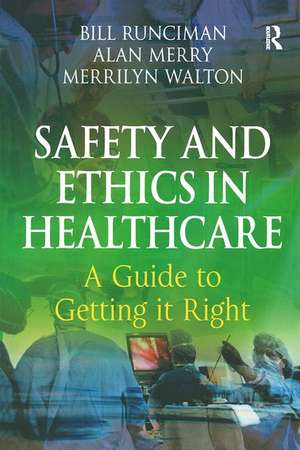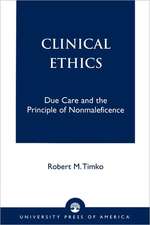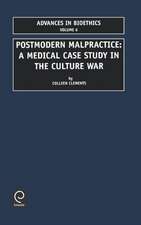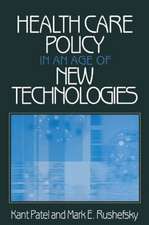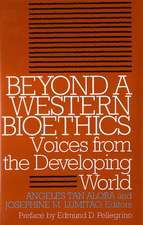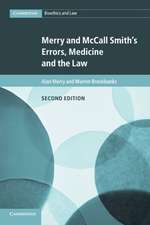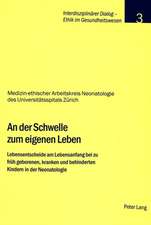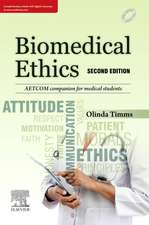Safety and Ethics in Healthcare: A Guide to Getting it Right
Autor Bill Runciman, Alan Merry, Merrilyn Waltonen Limba Engleză Paperback – 19 feb 2007
| Toate formatele și edițiile | Preț | Express |
|---|---|---|
| Paperback (1) | 459.05 lei 6-8 săpt. | |
| CRC Press – 19 feb 2007 | 459.05 lei 6-8 săpt. | |
| Hardback (1) | 1007.36 lei 6-8 săpt. | |
| CRC Press – 19 feb 2007 | 1007.36 lei 6-8 săpt. |
Preț: 459.05 lei
Nou
Puncte Express: 689
Preț estimativ în valută:
87.84€ • 91.71$ • 72.70£
87.84€ • 91.71$ • 72.70£
Carte tipărită la comandă
Livrare economică 04-18 aprilie
Preluare comenzi: 021 569.72.76
Specificații
ISBN-13: 9780754644378
ISBN-10: 0754644375
Pagini: 360
Ilustrații: Includes 70 b&w illustrations
Dimensiuni: 156 x 234 x 19 mm
Greutate: 0.68 kg
Ediția:New ed
Editura: CRC Press
Colecția CRC Press
Locul publicării:United Kingdom
ISBN-10: 0754644375
Pagini: 360
Ilustrații: Includes 70 b&w illustrations
Dimensiuni: 156 x 234 x 19 mm
Greutate: 0.68 kg
Ediția:New ed
Editura: CRC Press
Colecția CRC Press
Locul publicării:United Kingdom
Public țintă
Academic and Professional Practice & DevelopmentCuprins
Contents: Foreword; Preface. Part 1 What is Wrong with Healthcare: Setting the stage: an overview of healthcare; Risk and the harm caused by healthcare; Healthcare: a dysfunctional system; Naming, blaming and shaming. Part 2 Understanding the Basics: Human error and complex systems; Knowing what to do; Ethics, professional behaviour and regulation. Part 3 What to Do When Things Go Wrong: When things go wrong: looking after the people involved; When things go wrong: preventing a recurrence. Part 4 Preventing Things from Going Wrong: Getting the best out of people; Getting the best out of the system; Where to now? Appendices: Preferred terms and definitions for key safety and quality concepts; Public expenditure on healthcare in selected countries; Risk matrix; Evidence-based medicine: sources of information; International code of medical ethics; Jonsen's ethics framework; Severity assessment code (SAC); The advanced incident monitoring system (AIMS); Soft systems methodology (SSM); Sources of information for patients. Index.
Notă biografică
Bill Runciman is Professor of Anaesthesia and Intensive Care at the Adelaide University and Head of the Department of Anaesthesia and Intensive Care at the Royal Adelaide Hospital. He founded the Australian Patient Safety Foundation in 1988, and is the current President. He has been a member of task forces which produced world patient safety standards for both Anaesthesia and Intensive Care. He was Chairman of the Safety and Quality of Practice Committee of the World Federation of Societies of Anaesthesiologists from 1992 to 2000. He has been a member of the Australian Council for Safety and Quality in Healthcare and of the Australian Health Information Council, and is joint co-ordinator of groups developing research tools and an International Patient Safety Classification for the World Alliance for Patient Safety of the World Health Organization. Alan Merry is Professor of Anaesthesiology at the University of Auckland. He chairs the Quality and Safety Committee of the World Federation of Societies of Anaesthesiologists. He is a Councillor of the Australian and New Zealand College of Anaesthetists, chairs the College's Quality and Safety Committee, and has chaired its New Zealand National Committee. He co-chaired the New Zealand Medical Law Reform Group and has been president of the Auckland Medico-Legal Society. He is co-author of the books Errors, Medicine and the Law (with Alexander McCall Smith; Cambridge University Press, 2001) and Essential Perioperative Transoesophageal Echocardiography (with David Sidebotham and Malcolm Legget; Butterworth-Heinemann, 2003). Merrilyn Walton is an Associate Professor in the Faculty of Medicine at the University of Sydney. She chairs the Personal and Professional Development Theme and teaches students and clinicians about ethical practice, quality and safety. Her interests include enhancing the training environment for medical students and doctors and advocating for patients to be fully engaged in health care at every level. She was the founding Commissioner for the NSW Health Care Complaints Commission (1993-2000), and is a board member of the NSW Institute for Medical Education and Training and chairs its Prevocational Training Council.
Recenzii
'This book is indeed a worthy addition to the debate on healthcare safety and quality. It is accessible and underscores the essential humanity in providing safe, technically advanced care. Fucusing on health systems shifts responsibility away from a simplistic individual or profession approach to a collective approach where all the stakeholders are involved: individuals, patients, healthcare teams, organisations, together with local, national and international levels of healthcare policy and decision making. Nurses' experiences in healthcare teams are not well-discussed: issues such as the impact of staff shortage and fatigue are discussed from a predominantly medical point of view. Having said this, I recommend strongly that nursing leaders read and re-read this book. Above all, it is imperative that systems and professionals provide effective and safe healthcare, and this rests with the whole healthcare team.' Journal of Advanced Nursing, 2007 '...this book is very good value and should be readily available in every area of our healthcare system. I am not aware of any other text so up to date and comprehensive.' Anaesthesia and Intensive Care Vol 35 No 5 October 2007 'The authors treat the topic "safety management in medicine" and turn thereby to one of the most urgent areas of research and development in surgery. Particularly in chapters 2 "Understanding the basics" and 3 "What to do when things go wrong" definitions and concepts from the field of Human Factors are introduced which are unknown in surgery so far. This is of great importance, because due to the introduction of assistance systems and advanced workflow-management techniques into the operating room, an enormous need exists to arrive at such a new description of the hospital as a high-risk environment. Our working group already took over numerous recommendations of the authors. For example, a meeting to openly discuss complications during surgical procedures was established on a regular basis. In ad
Descriere
A single coherent source of information on the various interlinking domains of patient safety, litigation and ethical behaviour, based on accounts of real-life situations and intended for all healthcare students, specialists and administrators.
